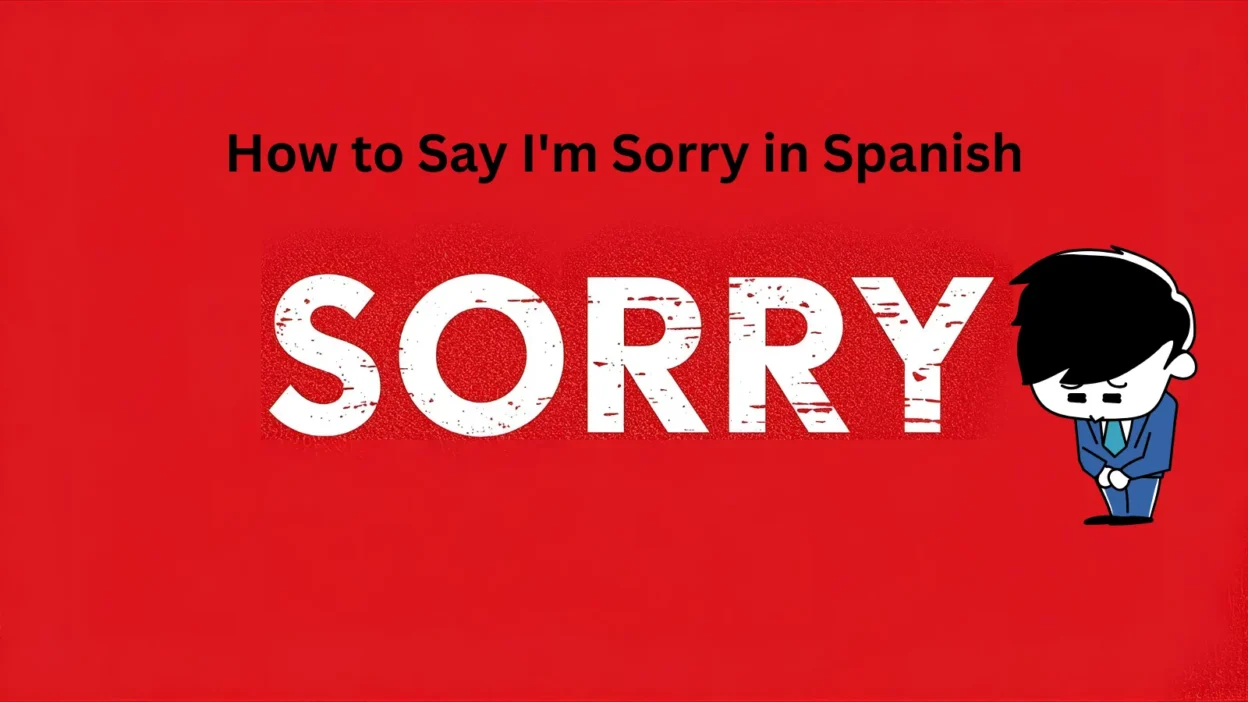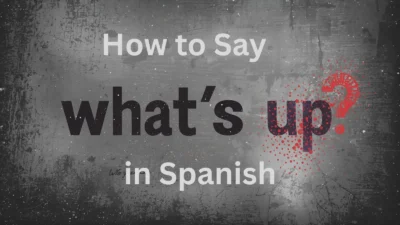How to Say I’m Sorry in Spanish is an essential phrase to learn if you want to express regret, apologize, or show empathy in conversations. In Spanish, there are different ways to say sorry depending on the situation—whether you’ve made a small mistake or need to make a heartfelt apology.
Mastering these expressions will help you communicate politely and respectfully with Spanish speakers. Common phrases like lo siento and perdón are widely used in daily life.
Learning when and how to use them makes your apologies sound sincere and natural.
I’m Sorry in Spanish
Let’s explore 15 different ways to say I’m sorry in Spanish, complete with real-life dialogue and cultural insight.
15 Ways to Say I’m Sorry in Spanish
| No. | Spanish Phrase | Pronunciation | Meaning / Usage |
|---|---|---|---|
| 1 | Lo siento | lo SYEN-to | I’m sorry (general/apology) |
| 2 | Perdón | pehr-DOHN | Sorry/excuse me (casual) |
| 3 | Disculpa | dees-KOOL-pah | Excuse me / sorry (informal) |
| 4 | Disculpe | dees-KOOL-peh | Excuse me / sorry (formal) |
| 5 | Perdóname | pehr-DOH-nah-meh | Forgive me (informal/apology) |
| 6 | Perdóneme | pehr-DOH-neh-meh | Forgive me (formal) |
| 7 | Lo lamento | lo lah-MEN-to | I regret it (more formal) |
| 8 | Mis disculpas | mees dees-KOOL-pahs | My apologies |
| 9 | Mil disculpas | meel dees-KOOL-pahs | A thousand apologies (very sorry) |
| 10 | Te pido perdón | teh PEE-do pehr-DOHN | I ask for your forgiveness |
| 11 | Siento mucho | SYEN-to MOO-choh | I’m very sorry |
| 12 | Lamento mucho | lah-MEN-to MOO-choh | I deeply regret it |
| 13 | Perdona | pehr-DOH-nah | Sorry (casual, to a friend) |
| 14 | Con permiso | kohn pehr-MEE-so | Excuse me (when passing by) |
| 15 | Me equivoqué | meh eh-kee-voh-KEH | I made a mistake / I’m sorry |
1. Lo siento – “I’m sorry”

Origin:
Literally means “I feel it.” It’s the most direct and universally recognized way to say “I’m sorry” in Spanish.
Example:
👤 Usuario A: Lo siento por llegar tarde.
👤 Usuario B: No te preocupes, todavía no hemos empezado.
Use: General apology, suitable for both formal and informal settings.
2. Perdón – “Pardon / Excuse me / Sorry”
Origin:
Derived from the Latin perdonare meaning “to forgive.” Commonly used when bumping into someone or interrupting.
Example:
👤 Usuario A: Perdón, no te vi.
👤 Usuario B: Está bien, no fue nada.
Use: Mild, polite apology in daily interactions.
3. Disculpa – “Excuse me / Sorry” (informal)

Origin:
From disculpar, meaning “to excuse.” More casual than “perdón,” often used among friends or peers.
Example:
👤 Usuario A: Disculpa, ¿tienes un momento?
👤 Usuario B: Claro, dime.
Use: Informal situations or minor offenses.
4. Disculpe – “Excuse me / Sorry” (formal)
Origin:
Formal version of disculpa; adds respect, especially when addressing elders or strangers.
Example:
👤 Usuario A: Disculpe, señor, ¿esta silla está ocupada?
👤 Usuario B: No, adelante.
Use: Polite and respectful; ideal for public or professional settings.
5. Lo lamento – “I regret it / I’m deeply sorry”
Origin:
Stronger and more emotional than lo siento, lo lamento conveys deeper remorse or sorrow.
Example:
👤 Usuario A: Lo lamento mucho por tu pérdida.
👤 Usuario B: Gracias por tus palabras.
Use: Serious or emotional situations (death, tragedy, heartbreak).
6. Mil disculpas – “A thousand apologies”

Origin:
An exaggerated but kind expression to show sincerity. Common in both Spain and Latin America.
Example:
👤 Usuario A: ¡Mil disculpas! No sabía que era tu turno.
👤 Usuario B: No te preocupes, pasa.
Use: Casual but heartfelt; for misunderstandings or small offenses.
7. Perdóname – “Forgive me”
Origin:
A more direct and emotional request for forgiveness. Often used in romantic or personal situations.
Example:
👤 Usuario A: Perdóname, no quise herirte.
👤 Usuario B: Está bien… pero necesito tiempo.
Use: Intimate or serious apologies.
8. Discúlpame – “Excuse me / Forgive me”
Origin:
A blend between disculpa and perdóname, often used to acknowledge guilt with softness.
Example:
👤 Usuario A: Discúlpame, olvidé tu cumpleaños.
👤 Usuario B: Lo entiendo, gracias por decirlo.
Use: Friendly but honest apology.
9. Con permiso – “Excuse me” (used before interrupting or passing by)
Origin:
Literally “with permission.” It’s a polite cultural norm in Spanish-speaking countries, especially in public spaces.
Example:
👤 Usuario A: Con permiso, ¿puedo pasar?
👤 Usuario B: Claro, adelante.
Use: Not for mistakes—used to excuse an action before doing it.
10. No quise hacerlo – “I didn’t mean to do it”
Origin:
A phrase to clarify intention and reduce blame.
Example:
👤 Usuario A: No quise hacerlo, fue un accidente.
👤 Usuario B: Lo sé, tranquilo.
Use: When explaining accidental behavior.
11. Fue sin querer – “It wasn’t on purpose”
Origin:
An idiomatic way to say “I didn’t do it intentionally.” Common with children and in informal situations.
Example:
👤 Usuario A: ¡Tiraste mi cuaderno!
👤 Usuario B: ¡Fue sin querer!
Use: Casual, used for accidents or slip-ups.
12. Me equivoqué – “I made a mistake”

Origin:
From the verb equivocarse, meaning “to be wrong.” Acknowledges error and responsibility.
Example:
👤 Usuario A: Me equivoqué al decir eso.
👤 Usuario B: Agradezco que lo reconozcas.
Use: Mature and accountable apology.
13. Te pido disculpas – “I ask for your forgiveness”
Origin:
A very respectful and formal way to say sorry, used in business or public speeches.
Example:
👤 Usuario A: Te pido disculpas por mi comportamiento ayer.
👤 Usuario B: Gracias por tu sinceridad.
Use: Formal, diplomatic, or written apologies.
14. Siento mucho lo ocurrido – “I’m very sorry for what happened”
Origin:
Combines lo siento with extra emphasis on the event.
Example:
👤 Usuario A: Siento mucho lo ocurrido en la reunión.
👤 Usuario B: Gracias. Fue un malentendido, nada grave.
Use: Formal or heartfelt.
15. Perdona la molestia – “Sorry for the trouble”
Origin:
Often used in customer service or polite requests to acknowledge inconvenience.
Example:
👤 Usuario A: Perdona la molestia, ¿me puedes ayudar con esto?
👤 Usuario B: Claro, dime en qué te ayudo.
Use: Semi-formal, polite context.
FAQs
1. What is the most common way to say “I’m sorry” in Spanish?
The most common way is “Lo siento” (pronounced: loh syen-toh).
2. Can “Lo siento” be used in all situations?
Yes, it works in both casual and serious situations.
3. How do I say “I’m very sorry” in Spanish?
Say “Lo siento mucho.” It shows deeper regret.
4. What if I want to apologize for a mistake I made personally?
Use “Perdón” meaning “Pardon me” or “Sorry.”
5. What is the difference between “Lo siento” and “Perdón”?
- Lo siento = You feel sad or sorry about something.
- Perdón = You are asking for forgiveness or excusing yourself.
6. How do you say “I apologize” in Spanish?
Say “Pido disculpas.”
7. How do you say “My bad” in Spanish (casual)?
You can say “Fue mi culpa.” (It was my fault.)
8. How do you say “Sorry for being late” in Spanish?
Say “Perdón por llegar tarde.”
9. How do you say “I didn’t mean to” in Spanish?
Say “No fue mi intención.”
10. How do you respond when someone says “Lo siento”?
You can reply with “Está bien” (It’s okay) or “No te preocupes” (Don’t worry).
Conclusion:
knowing how to say I’m sorry in Spanish helps you express politeness, empathy, and respect in different situations. From the simple lo siento to the more formal disculpe, each phrase carries its own tone and meaning. By practicing these expressions, you’ll not only improve your Spanish but also build stronger, more genuine connections with native speakers.



